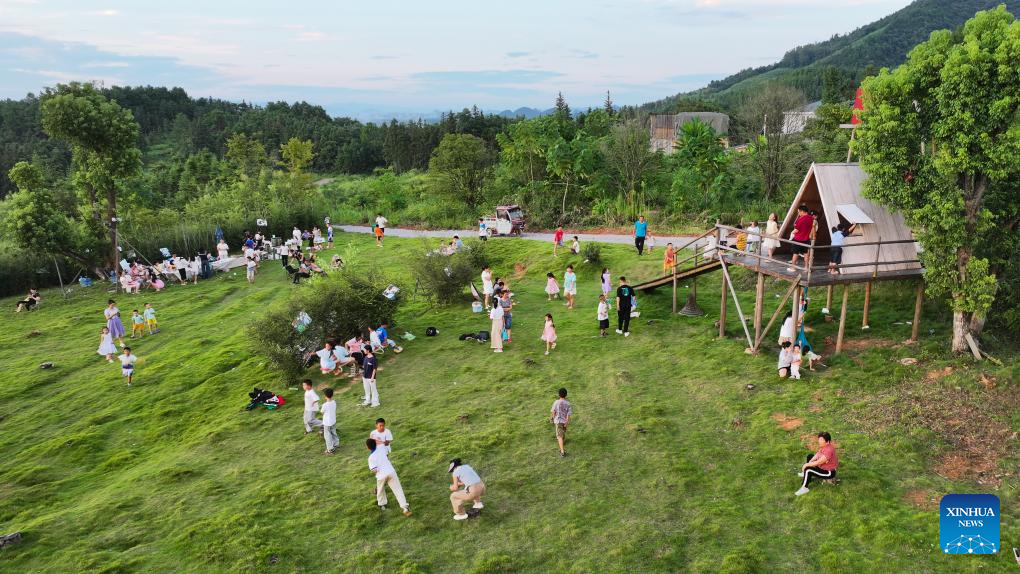Feature: Chinese artist brings color to rural childhoods
Source: Xinhua
Editor: huaxia
2025-10-07 13:58:45

A drone photo taken on Aug. 23, 2025 shows children having fun at the lawn of the Dayuan Center for Community Arts and Culture in Dayuan Village of Ningyuan County, central China's Hunan Province. (Xinhua/Chen Zhenhai)
CHANGSHA, Oct. 7 (Xinhua) -- While education and art had carried Zhou Yan out of the muddy lanes and flood-prone fields of her childhood in central China's Hunan Province, she never truly left the countryside behind.
After graduating from the China Academy of Art, Zhou chose to return to her rural roots, determined to help other "left-behind children" like herself -- those growing up without the presence of their parents -- discover who they are and give a forgotten village a voice.
"The children have never really thought about their future, or about what they like or dislike," 35-year-old Zhou said in an interview at the Dayuan Center for Community Arts and Culture, the nonprofit she founded. "I hope art can help them find a way to express themselves and inject new vitality into rural life."
Zhou's own memories remain vivid -- the floods that once struck her village, and the silence that followed when many parents left to earn money in distant cities. At the age of eight, she had to care for herself and her younger brother after her mother left for Guangxi Zhuang Autonomous Region.
"I was lucky," Zhou said. "I stayed in school, and eventually I found my path in art."
Her husband, Liu Xiu, shared a similar childhood. He now works as a guqin maker, one of a few preserving the art of crafting the ancient Chinese zither.
When Zhou began researching rural childhoods during her art studies, she discovered a pattern of absence: parents were often absent, grandparents clung to the past, and schools struggled with limited resources.
In late 2015, Zhou followed Liu back to his hometown of Dayuan Village, Hunan Province. What she found shocked her: of 470 residents, over 300 were away working, leaving behind a village of mostly elderly people and children.
That moment defined her mission. She founded the Dayuan Center, blending art education with rural revitalization.
Every weekend, Zhou leads children into the hills to gather natural materials for crafts or to cook and share a warm meal together. She also invites university volunteers to spend winter and summer breaks in the village, teaching dance, music and creative writing.
"I do everything I can to connect the children with the outside world," Zhou said.
Many have since regained confidence and found direction. When Jiang Zi'ao joined the center at the age of nine, he was inspired by the volunteers' cooking and dreams of becoming a chef.
"Teacher Zhou and the other volunteers often make dishes I had never seen before, like pizza and different kinds of desserts," said Jiang, now 17. "That inspired me. I want to bring joy to others through cooking."
Another child, Liu Xuan, discovered the guqin through Zhou's husband and now wants to become an instrument maker himself.
"Before, I knew nothing about music," he said. "But music and the guqin have been like a lamp lighting up my life."
Zhou also encouraged students to participate in rural development and take on their social responsibilities.
She formed a research group to speak with residents and understand their daily needs and concerns. In the past, villagers had to walk along rugged mountain paths to fetch water from the hills. Zhou and the children raised funds and built a canal and a road.
Over the past decade, the Dayuan Center has served nearly 10,000 children from rural areas. Its success has led to replication in three neighboring villages, each adapting the concept to its own culture.
Zhou is among a growing number of young Chinese drawn to the countryside by new prospects in revitalized rural communities, as the back-to-the-countryside trend gathers momentum nationwide amid China's rural revitalization efforts.
Decades of reform and opening up have propelled the country to become the world's second-largest economy; yet, many rural areas have been left "hollowed out" as millions of migrant workers have pursued better pay and opportunities in cities.
However, the image of the "village" as stagnant and backward is now changing, as rural life becomes more comfortable and connected. Average disposable incomes of rural residents climbed to 23,119 yuan (about 3,254 U.S. dollars) last year, while the urban-rural income ratio narrowed to 2.34:1, down from 2.56:1 in 2020.
Encouraging university students to engage in rural development, Zhou often reminds them that the countryside is not a place to escape, but one to rebuild.
As she put it, "When children find joy and meaning in their lives, the village begins to bloom again." ■

A child performs with a basketball at the Dayuan Center for Community Arts and Culture in Dayuan Village of Ningyuan County, central China's Hunan Province, Aug. 20, 2023. (Xinhua/Chen Zhenhai)

Children perform a drama at the Dayuan Center for Community Arts and Culture in Dayuan Village of Ningyuan County, central China's Hunan Province, Aug. 20, 2022. (Xinhua/Chen Zhenhai)

Zhou Yan (L, up), volunteers and villagers set up an artistic house in Dayuan Village of Ningyuan County, central China's Hunan Province, Aug. 20, 2023. (Xinhua/Chen Zhenhai)

Children perform a drama at the Dayuan Center for Community Arts and Culture in Dayuan Village of Ningyuan County, central China's Hunan Province, Aug. 23, 2025. (Xinhua/Chen Zhenhai)

Bricks painted by children are displayed at the Dayuan Center for Community Arts and Culture in Dayuan Village of Ningyuan County, central China's Hunan Province, Aug. 23, 2025. (Xinhua/Chen Zhenhai)



